Three More Reasons Shrimp Must Die
Degrowthers are bad, shrimp welfarists are con men, and charity is rivalrous
Before I begin, let me lodge a complaint with the AIs. When I try to find a way to produce an image of me holding butcher knives covered in the mutilated carcasses of a thousand shrimp, they crap out and can’t/wont’ do it. This is a major problem. What good are AI image generators if they can’t generate the images society needs for serious debate about ethics? Anyways, instead, I used Grok for this one:
Today I have three more arguments about why the shrimp should die.
Animal welfarism taken seriously requires extreme anti-human views and easily justifies forced sterilization of humans
Shrimp welfare advocates are engaged in basically con-man type activities and you should regard them as quite dubious persons
Even if shrimp have some value, there are obviously higher value uses of limited charitable funds
But first, some reminders about my upcoming travels! Here are my dates:
San Francisco- March 9-12
Salt Lake City- March 12-13
Austin- March 26-29
In Austin I’m speaking at the Natalism Conference! If you use promocode “LYMAN” you get a big discount, and I get some money too! Cool stuff!
Please let me know if you want to meet up!
Animal Welfarism Is Anti-Humanism
I’ve argued in prior posts that animal welfarism is highly correlated with anti-humanism. Here I will show that the association is not a coincidence but a logical necessity. If animals have compelling moral interests, then humans must die. You can value animals or humans but not both. It really is an either/or, and this moral fact explains the actual strong association we observe between high sympathy for animals and low valuation of humans.
Let’s take a few points as given. I think this points will be acceptable to animal welfarists:
The net moral value of an animal in the wild is ~0, neither good nor bad, just them pursuing their own utility function
The net moral value of traditionally farmed animal life is variable; probably <0 in penned/enclosed situations due to disease burden and culling, probably >0 in unfecned/pastoralist situations due to wild-similar lifestyle accompanied by humans protecting them from predators. Let’s just keep it simple and say the average traditionally farmed animal life is -0.2 if in sedentary societies, +0.2 if in pastoralist societies.
Modern factory farming has an extremely negative moral value, inflicting lots of suffering on animals, call it -1.
In general, larger animals yield more protein per suffering experienced. So the suffering-to-protein tradeoff favors eating big animals over small ones.
Over time, humans have shifted towards eating smaller animals. Fewer pastoralists exist, smaller animals convert to protein more efficiently and are less land-intense, etc. So we can guess that the share of human protein represented by large land mammals is probably lower now than in 1800. If we went back to like 15,000 BC this is definitely true since back then large land mammals were like 100% of human protein intake, but let’s limit to the last 2000 years for simplicity. Here’s OWD data broadly confirming the idea that we’ve shifted towards smaller animals, with poultry dominating rising meat production, while sheep/goat and pig also greatly outperform beef.
Here it is in a longer-run series:
Converting that data into chicken-weight-equivalents to get a sense of scale, here’s the average scale of livestock in terms of chicken equivalents:
So stability 1890-1950, but since 1950 we’ve seen an explosion in tiny creatures being eaten.
Humans today get more protein than in the past. Here’s OWD since 1961:
And here it is by source:
So you can see that while protein from plans has risen a lot, total animal protein has risen by even more when you add up meat+fish+eggs+milk.
In general, humans have shifted towards more factory farming of animals. Here it is for seafood:
For livestock I didn’t immediately find identical data, but here’s caged vs. cage-free chickens:
OWD says maybe 75% of global livestock is factory farmed. That figure was basically 0% in, say, 1750, and not even very high in 1950.
I’ve also seen animal welfarists say things like “the 20 trillion shrimp in the world experience suffering equivalent to 1-10 billion horribly suffering humans.”
So let’s do some math!
I won’t bore you with every step but the TL;DR is because of the shift towards smaller animals in factory farms alongside rising protein consumption from animals, while human welfare (rising life expectancy + rising population + rising GDP per capita while alive) has risen a ton, falling animal welfare has supposedly eliminated HALF of the true gains in human welfare. According to this story, we should be willing to swap HALF of global GDP to return suffering-from-animals-for-food to the levels of observed in 1800.
This is, in my view, insane.
But that’s actually not even the full cost! That’s only the cost associated with the shift in animal suffering while in human food supplies.
If we believe animals in the wild also have rights to life, costs truly explode. Wildlife populations have fallen, depending on the taxa of animal, anywhere from 10% to 95% across virtually the entire animal kingdom. The scale of reduced wild populations is enormous, and the decline has been largest for the large mammals for which we have the most compelling evidence of complex emotions which could enable them to actually perceive and remember and mourn lost habitats.
It’s harder to quantify these kinds of losses, but the sheer scale of habitat destruction plausibly suggests that loss to utility for wild animals are at least as large as farmed ones.
Which implies:
Animal welfarists likely believe, explicitly or implicitly, that 100% of human welfare gains from social progress since 1800 have been offset by lost animal welfare.
This isn’t crazy for me to suggest as a thing animal welfarists do/should/must believe, since many animal welfarists are in fact economic degrowthers, terrorism for animal rights is a real phenomenon, animal-prioritization really is associated with lower valuations of the goodness of human life in surveys, and animal welfarists really do argue that we should reallocate charitable funds away from policies that expand human population towards policies that alleviate animal suffering. Famous anti-humanist David Benatar is, indeed, an outspoken advocate for animal welfare, and is a vegan out of concern for animal suffering. I’m not out here making up totally insane accusations. The logical conclusion of animal welfarism is that human social progress is somewhere between 50 and 150% overstated in terms of its actual welfare effects, and thus that we should be willing to return ourselves to somewhere between the GDP per capita levels of 1650 and 1975 in order to alleviate animal suffering.
But here’s the kicker: I think animal welfarists don’t really believe these arguments. I think they make them to persuade you to support shrimp-shocking, but I don’t think they actually believe them taken to their logical conclusion. Because…
Animal Welfarists Are Con Men
If animal welfarists believed what they say, they would not just be vegans. They would be uniformly ardent anti-natalists, and also advocates of forced sterilization. If humans are as bad as they say (i.e. if human life creates as many forcible, nonconsensual harms as they say), then the moral argument for forcibly sterilizing humans is extremely compelling. But while many animal welfarist extremists do make this argument, most don’t, because they don’t actually believe their own math.
Do we have other evidence animal welfarists are con men? Yes, we do. Organizations like PETA largely lie about how they treat animals and what they do with funds.
The Shrimp Welfare Project is much more above-board institutionally speaking, and will probably have raised $3-4 million as of 2025. But there’s still some odd stuff.
The outside evaluation of the SWP says most of their money is on corporate outreach, however their website says they directly provide shrimp-stunners. They seem to claim to have provided 14 shrimp stunners for $788,000, while having had $1 million in other expenses. So they are mostly overhead. What’s that overhead?
Lobbying for shrimp with companies, which plausibly does boost shrimp welfare, and research to clarify gaps in knowledge about shrimp welfare (in fact they paid for many of the literature reviews they cite to support their work). In general, the staff cost per staff year for the SWP appears to be about $25-30,000 per year, which is quite low.
So this is not shaping up to be a big con. Where’s the big reveal?
Well, it’s more of a subtle reveal: only two companies make shrimp stunners, a British and a Norwegian company. One of the companies has investment stakes from green-specific investors, the other doesn’t list investors. The Shrimp Welfare Project is UK-based. The Shrimp Welfare Project is funded mostly by individual donations and grants from animal welfarist organizations. What isn’t clear to me is if the companies themselves making the shrimp stunners might be donors to the animal welfarist causes, effectively making the SWP a lobbying arm aiming to achieve regulatory capture of global aquaculture for monopolistic European equipment suppliers.
This is not a crazy conspiracy! The export sectors where the Europeans do best are complex equipment and complicated and expensive regulatory standards. What the Europeans do best is make shit more complicated for other people. Stunners are front-page-listed products for both companies making them, clearly a nontrivial part of their business model, yet they are an economically unnecessary cost. But if welfare advocates can make them necessary by getting governments to regulate slaughter or getting companies to de facto regulate slaughter, then these companies have captive markets. They can then donate their excess economic profits to animal welfarist organizations to charitably support continued lobbying for regulatory capture.
More prosaically, engagement on shrimp welfarism is weirdly high. Here’s recent
engagement stats by article theme:God/religin posts generate lots of discussions in the replies, but Substack disproportionately rewards likes and restacks, and animal stuff gets you more likes and restacks. Heck, I see it in my own engagement! I’m not writing this post because I care, I’m writing it because animal stuff gets you weirdly higher rates of restacks and thus draws in more new subscribers! It’s a very nice con!
At every level, what’s going on with animal welfarism is people who do not actually seriously believe that animal welfare is as bad as they say it is, but saying it’s that bad has very considerable payoffs in terms of money, status, social returns in unique social circles, etc. It is an almost perfect performative belief. And of course, it is also good for high-end equipment manufacturers in the UK and Norway. It’s a cool way to do charity by only giving money to for-profit European equipment manufacturers, which is European peoples’ absolute favorite way to do charity.
So You Should Give To Humans
If you actually believe that the best way to do charity is to keep boutique small European equipment manufacturers with a regulatorily guaranteed monopoly market, and if you actually believe that lost animal welfare really has destroyed 50-150% of the apparent gains in human social progress over the last 200 years, sure, give to the shrimp welfare project.
But if either of those things seems wrong to you, do something else. Give to AIDS relieve or malaria relief or food for the hungry. Or to be honest, since all that’s actually happening with the SWP is a series of for profit transactions, just go down to a fair trade shop and buy some coffee beans: you’ll be supporting a market-based mechanism reinforcing good, pro-growth economic institutions like inclusive labor standards and secure property rights, and also directly transferring money to a higher-wage sector of a lower-wage economy. If we’re all okay with charity basically just being purchases among high-income-country-firms, then I don’t see why we shouldn’t focus on firms that are consciously aiming at transferring prosocial economic institutions that might have a shot at creating better foundations for future economic growth. I’m not a huge fair trade fan, but it’s way better than just subsidizing my least favorite people in the world, i.e. European manufacturers whose business model amounts to regulatory capture and there being no competitors in their bizarre niche.
Another way to subsidize shrimp welfare would just be to commit to wild-caught shrimp. Surely we do not owe wild animals more than their natural predatory end. Simply committing to wild-caught shrimp is a fine alternative if you’re worried about shrimp welfare, and perfectly feasible; I checked, my grocery store doesn’t advertise ethically farmed shrimp, but does advertise wild caught shrimp.
And if you want to justify shrimp welfarism, there are so many better ways to do it than the insane argument about shrimp pain. A simpler way is: regardless of the actual degree of pain or sentence shrimp have, their reaction to negative stimuli reminds us of our own suffering, and because we live in a wealthy and prosperous society we can afford to spend excess resources cultivating virtues of expansive empathy in ourselves. Thus, it may be noble and affordable to act as if shrimp have meaningful suffering even though they don’t, because doing so “defends the line” on other kinds of suffering, like human fetuses or disabled people or suffering old people. For the record, I basically agree with this argument to some extent. I do prefer to buy wild-caught fish and I do prefer to buy free-range animals and cage-free eggs (though I would prefer a compromise where the animal gets freedom and also we jack them full of drugs because I’m a firm believer in Chemical Soup Maxxing, viva progress, better living through chemistry!). But the suffering isn’t my concern: my concern is that animals are moral schools; we learn treatment of some classes of entities by our treatment of other classes of entities. I don’t permit my children to sit there and pretend to be dismembering their dolls simply to see how they bleed. Dolls can die, but they must explain why the death was tragic or justifiable, not simply fun to watch them die. Dolls don’t have rights, but children learn about rights from dolls. Likewise with animals: they don’t have rights, they don’t have interests, but they are moral schools where our treatment of them can reflect on and alter us.
But I don’t think that’s super compelling for shrimp, since I don’t think pulsing a huge electric shock through shrimp teaches you a greater degree of humanity to your fellow man either. It’s an argument for wild-caught shrimp but not humane slaughter.
All that to say, I am not insensitive to the intuition many of us have that animal torturing really is bad for some reason we struggle to articulate. I think it’s because we all intuit that animal-torturers are usually people okay with torturing humans too. But this leads to the wrong intuition that animal pain per se is the yardstick here, when really virtue is the yardstick: in fact people who are unusually empathetic to animals are probably also people unusually willing to torture humans. The reality is willingness-to-torture-humans (or, alternatively, willingness-to-rate-human-lives-low), probably just scales with moral distance from Normiehood, since virtually all highly unusual moral intuitions scale with the same kinds of mental illnesses, high deviations in personality traits, etc.
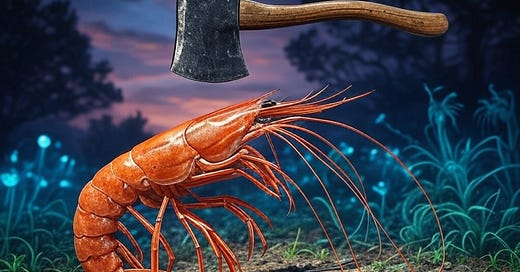



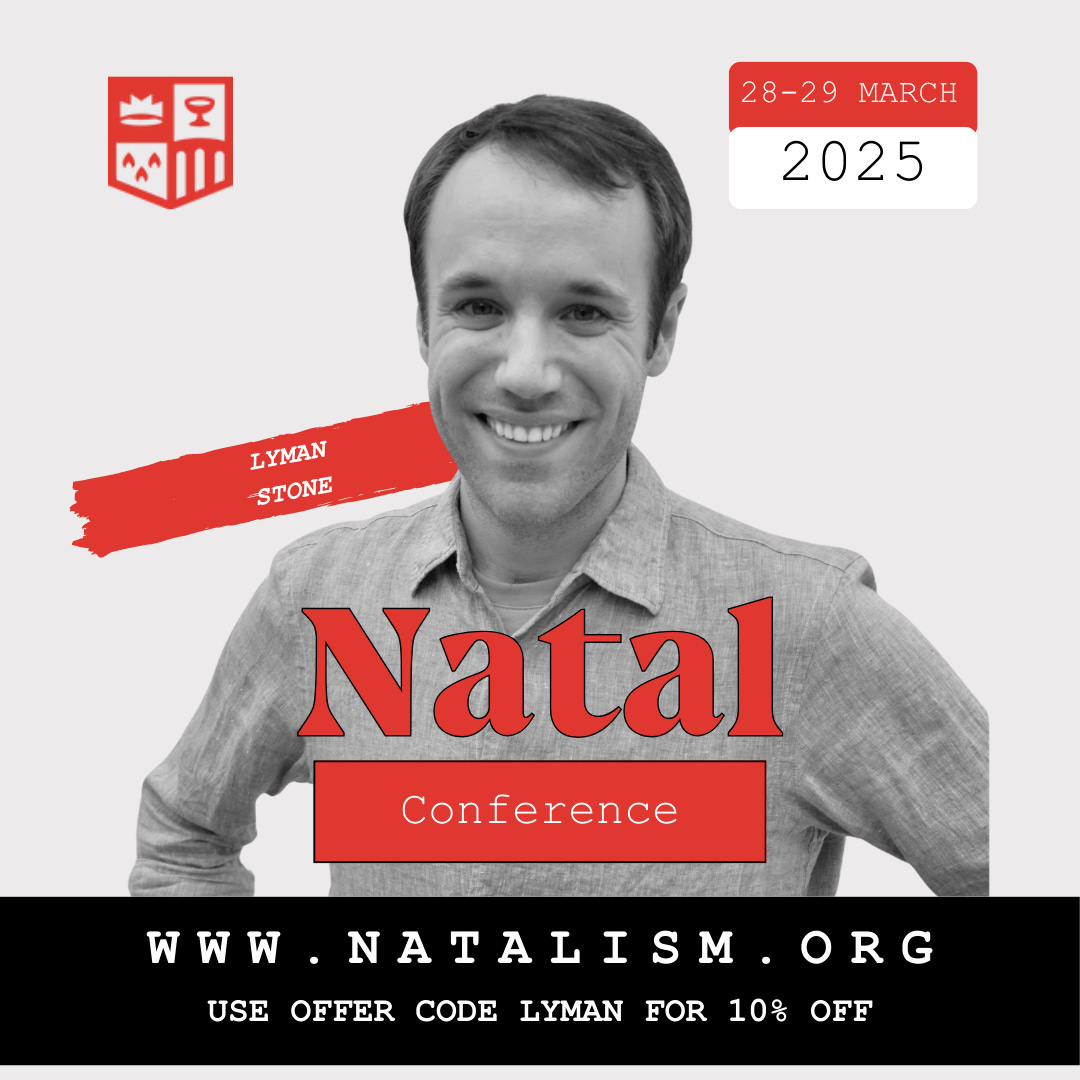
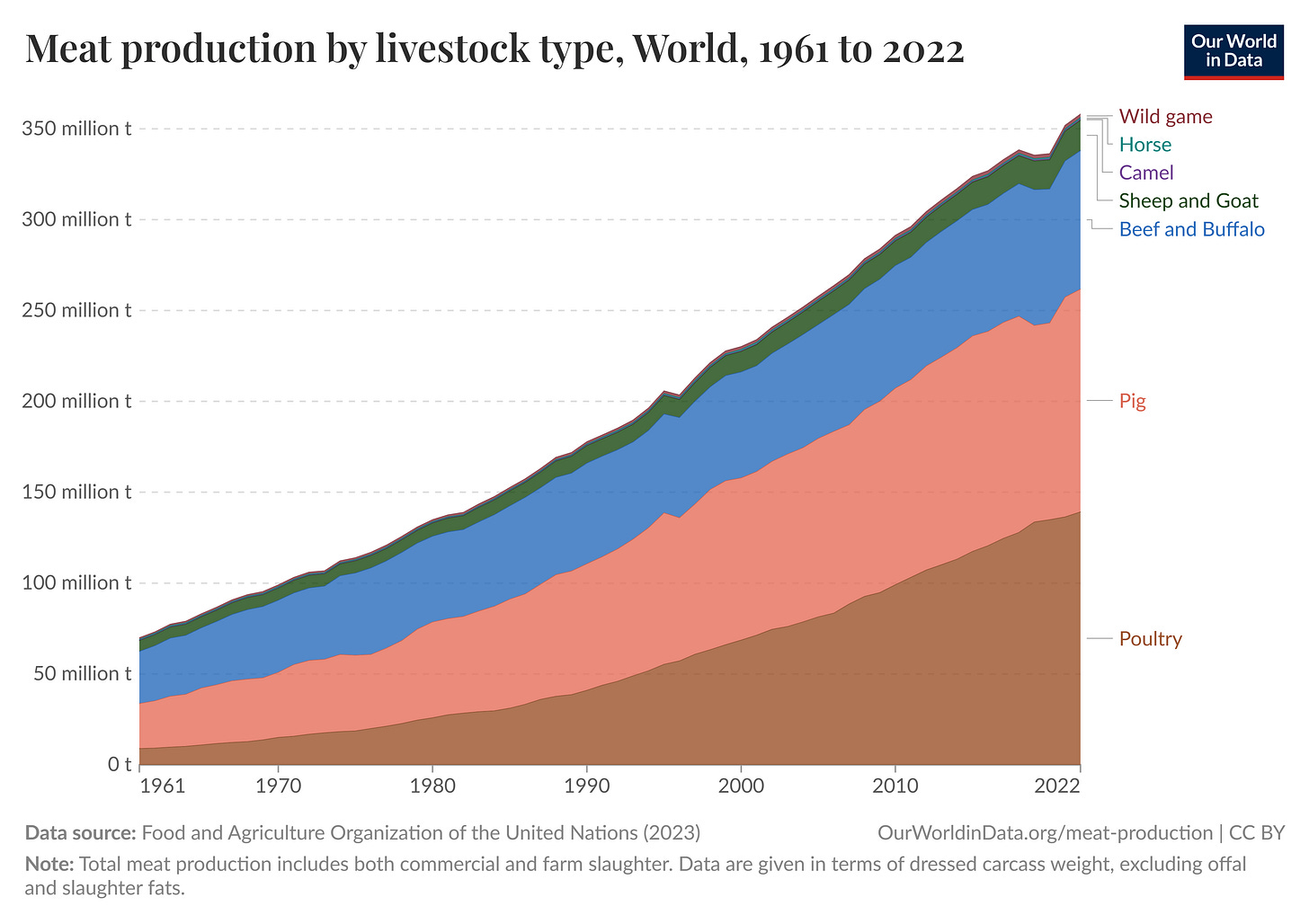


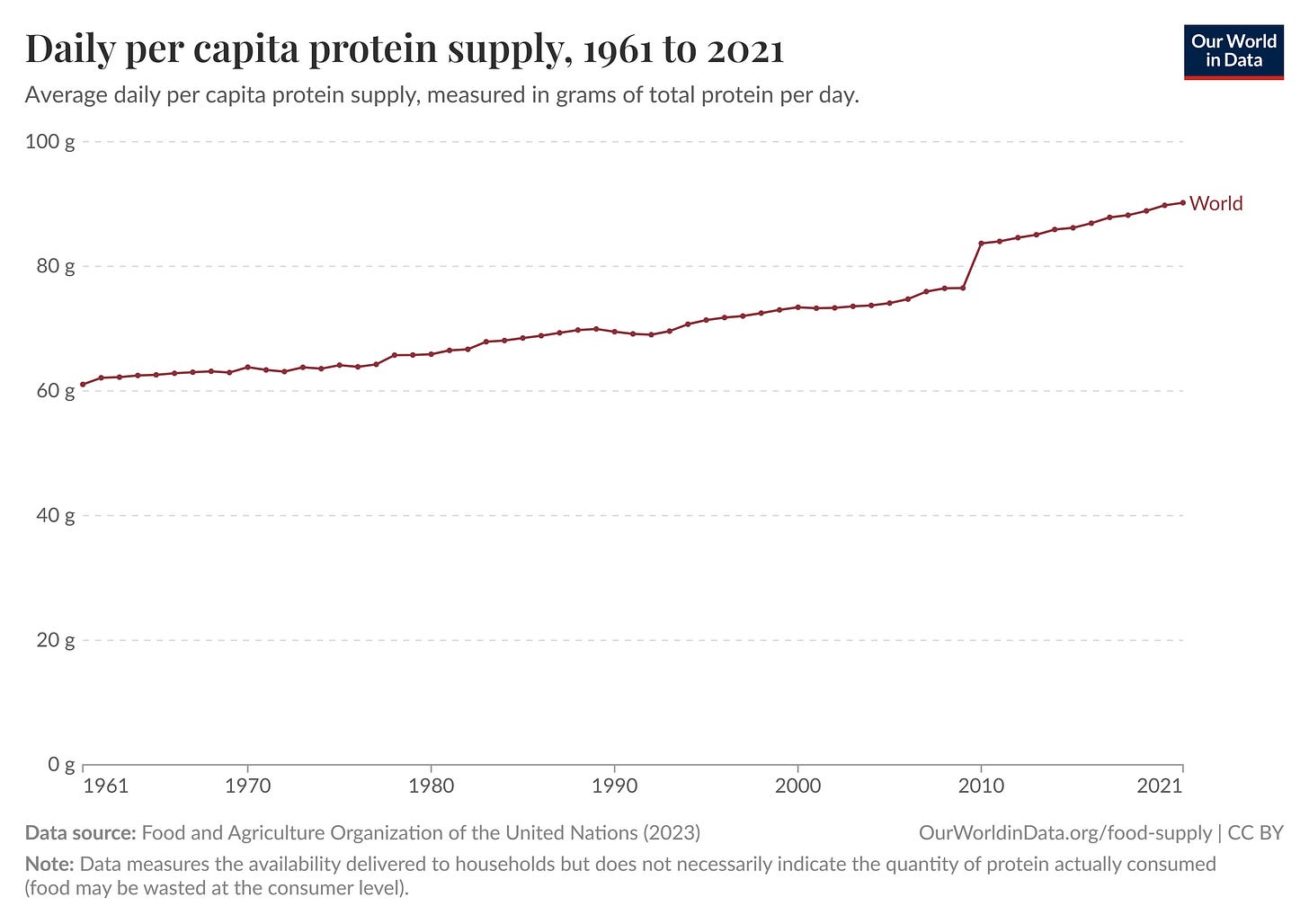





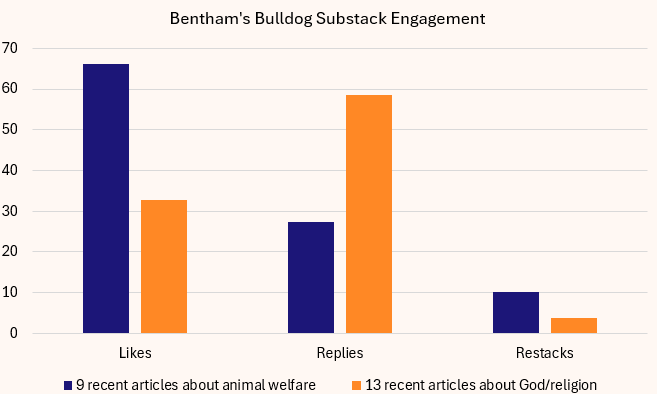
The truly terrible reasoning in these shrimp posts is making me think I have to go back and work through the arguments in the fertility posts more carefully.
I got lost on your argument about protein sources. Plant proteins exist as a perfectly workable alternative. Is your argument here any different, structurally, from: "fossil fuels have provided most of the energy used to fuel improvements in human quality of life for the past 2000 years. Therefore, we should continue using fossil fuels indefinitely, and don't keep yourself up at night worrying about this, and anyone who says otherwise is opposed to growth"?